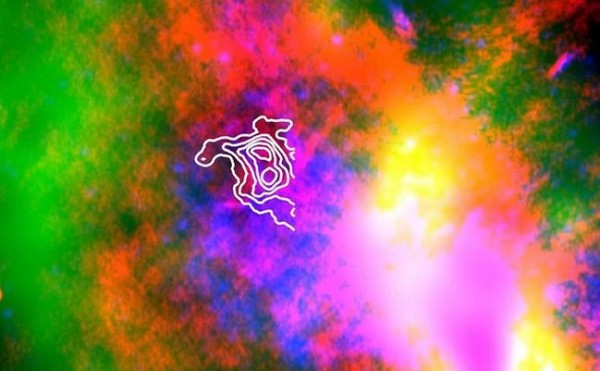Mystery Solved: Supernova did Give Birth to the Cosmic Dust in the Universe
| Arthur Dominic Villasanta | | Mar 20, 2015 10:40 AM EDT |
(Photo : Ryan Lau et al/SOFIA/FORCAST/Herschel/PACS/ Chandra/ACIS-I/VLA) The Sagittarius A East supernova remnant.
One of astronomy's most enduring mysteries -- why is the Universe so full of interstellar dust and where did this all of this dust come from -- has finally received a plausible explanation.
New observations confirm interstellar dust does indeed come from supernovae, a theory long thought to have been implausible. Supernovae are indescribably massive explosions that occur when stars run out of fuel (hydrogen), collapse into themselves and finally explode.
Like Us on Facebook
The Big Bang is thought to have flooded the Universe only with gases, mostly hydrogen that then formed the first stars and galaxies. The question left unanswered by this theory is where all the interstellar dust came from.
What scientists did know, however, was that inside stars, hydrogen nuclei fused into heavier elements and dust. Models suggest supernovae generate massive amounts of dust it hurls into space in an expanding mass of material called a supernova remnant.
But this supernova remnant (and the dust it created) is supposed to have been obliterated after it collided with the cooler gas between stars known as the interstellar medium.
New research has finally found out why the dust survived despite this annihilating event.
A team of astronomers using FORCAST (the Faint object Infrared Camera Telescope) mounted aboard the Stratospheric Observatory for Infrared Astronomy or SOFIA (a modified 747 jumbo jet) studied Sagittarius A East, a 10,000 year-old supernova remnant near the center of the Milky Way.
Using this instrument, researchers were able to directly observe this supernova. These observations led the team to conclude that 7% to 20% of the dust originally created by a supernova survived the shock wave, leading to the dust found in interstellar space.
"Dust itself is very important because it's the stuff that forms stars and plants, like the sun and Earth, respectively, so to know where it comes from is an important question," said Ryan Lau, lead author of the new study.
"Our work strongly reinforces the theory that supernovae are producing the dust seen in galaxies of the early universe."
"There have been no direct observations of any dust surviving the environment of the supernova remnant ... until now ...." said Lau.
©2015 Chinatopix All rights reserved. Do not reproduce without permission
EDITOR'S PICKS
-

Did the Trump administration just announce plans for a trade war with ‘hostile’ China and Russia?
-

US Senate passes Taiwan travel bill slammed by China
-

As Yan Sihong’s family grieves, here are other Chinese students who went missing abroad. Some have never been found
-

Beijing blasts Western critics who ‘smear China’ with the term sharp power
-

China Envoy Seeks to Defuse Tensions With U.S. as a Trade War Brews
-

Singapore's Deputy PM Provides Bitcoin Vote of Confidence Amid China's Blanket Bans
-

China warns investors over risks in overseas virtual currency trading
-

Chinese government most trustworthy: survey
-

Kashima Antlers On Course For Back-To-Back Titles
MOST POPULAR
LATEST NEWS
Zhou Yongkang: China's Former Security Chief Sentenced to Life in Prison

China's former Chief of the Ministry of Public Security, Zhou Yongkang, has been given a life sentence after he was found guilty of abusing his office, bribery and deliberately ... Full Article
TRENDING STORY

China Pork Prices Expected to Stabilize As The Supplies Recover

Elephone P9000 Smartphone is now on Sale on Amazon India

There's a Big Chance Cliffhangers Won't Still Be Resolved When Grey's Anatomy Season 13 Returns

Supreme Court Ruled on Samsung vs Apple Dispute for Patent Infringement

Microsoft Surface Pro 5 Rumors and Release Date: What is the Latest?










